
Diameter and radius sound like geometry, don’t they? But apparently, these terms are also used in VoIP and telecommunication technologies. Diameter is an authentication, authorization, and accounting (AAA) protocol that belongs to the application layer in the Internet protocol suite. Diameter protocol has evolved from its predecessor RADIUS (Remote Authentication Dial-In User Service) and the term is also derived from RADIUS (a diameter is twice the radius).
A variety of LTE and IMS network functions use diameter protocol. We’re talking about critical network functionalities like the Policy and Charging Rules Function (PCRF), Home Subscriber Server (HSS), and the Online Charging System (OCS).
Within this context, the protocol establishes a comprehensive framework for the AAA messages and response commands, along with associated attributes. This ensures a systematic approach to communication among network components, enhancing the efficiency of operations within modern telecommunications networks.
What is Diameter Protocol?

You have probably got an idea already. Now, let’s clear things out in simpler ways. The Diameter Protocol is a key player in mobile networks, especially in technologies like LTE and IMS. It’s like the upgraded version of older protocols, ensuring that our mobile data travels securely and efficiently.
Imagine Diameter as the behind-the-scenes manager for your mobile services. It is an extensible protocol to enable AAA function in IP and multimedia networks. Diameter is a peer-to-peer (P2P) network and in that network, a peer can work either as a client or a server. Unlike the previous protocol versions, in diameter, a server can send a request to its peers.
This protocol primarily focuses on enabling communication between different devices. It’s like a conversation between devices, where they confirm or deny messages to stay synchronized. To add an extra layer of reliability, Diameter uses TCP and SCTP, ensuring a robust connection that minimizes any chance of data loss.
Why is the Diameter Protocol Important?
The Diameter Protocol in telecom has become the preferred AAA protocol for both fixed and mobile networks since the advent of IP-based technology in telecommunications networks. It outshines legacy AAA solutions like RADIUS and serves as the fundamental framework for the Evolved Packet System (EPS) network, facilitating Long Term Evolution (LTE) technology.
Numerous standards bodies, including 3GPP and ETSI NFV, have embraced the Diameter Protocol as the cornerstone for AAA functionalities in the next generation of networks. This protocol stands alone in supporting critical upgrades in 4G, particularly the incorporation of real-time functionality for transactions.
Not only that, Diameter takes charge of monitoring the usage of services and resources within the network, contributing significantly to enhancing the security of the domain name system. It plays a vital role as the backbone of the Evolved Packet System network, a crucial component supporting LTE technology.
So, if we sum up and point out the importance of the Diameter Protocol we find the following essence from it—
- Diameter is the primary AAA protocol for fixed and mobile networks, surpassing RADIUS.
- It’s the foundation for LTE Technology. Diameter is the backbone of the EPS network which supports LTE technology.
- 3GPP and ETSI NFV endorse Diameter as the foundational AAA protocol for NGN.
- Versatility in 4G Upgrades is possible because of the Diameter Protocol. It is the exclusive protocol for implementing critical 4G upgrades, including real-time transactions.
- Diameter Protocol enables network Monitoring and Security Enhancement. Diameter actively monitors network usage, enhancing the security of the domain name system.
Relationship to SIP
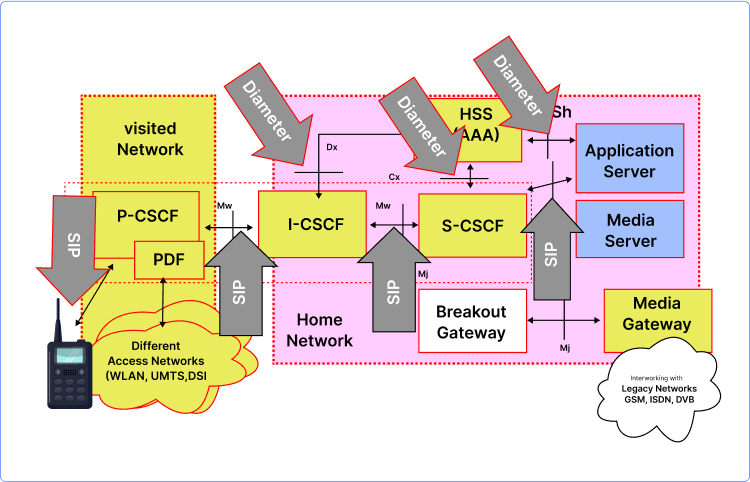
Diameter and SIP (Session Initiation Protocol) are vital in IMS networks. SIP is responsible for setting up and managing real-time IP communication sessions. On the other hand, Diameter handles tasks like authentication, authorization, and ensuring accurate billing information for these sessions. Together, they form a crucial partnership in ensuring effective and secure communication services within IMS networks.
How Does the Diameter Protocol Work?
The Diameter Protocol operates on a Peer-To-Peer architecture, allowing each host implementing it to function as either a client or a server, depending on the network structure. When a user initiates a connection request, the receiving Diameter node acts as the client. This client node, after gathering user credentials like a username and password, transmits an access request message to another Diameter node.
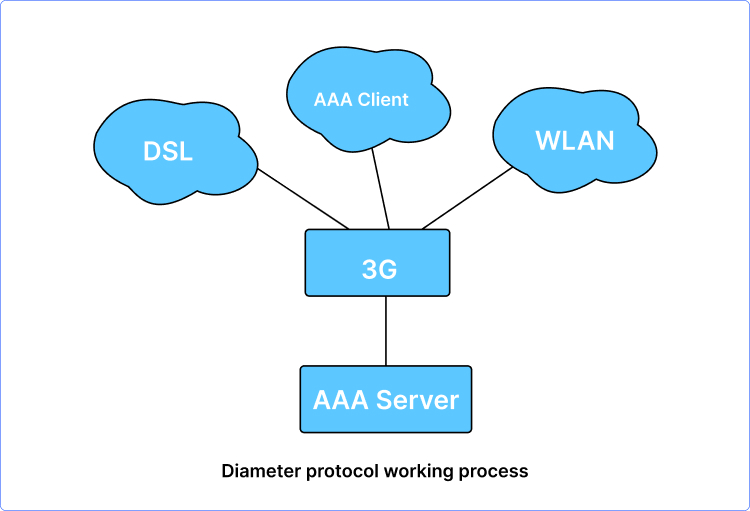
The receiving Diameter server node then authenticates the user based on the provided information. If accepted, an access response is sent back to the corresponding Diameter client; if rejected, an access denied message is dispatched. Diameter enhances Domain Name System (DNS) security by monitoring the utilization of services and resources.
Hang on, there is much more a diameter protocol does. In cloud environments, AAA services, crucial for supporting globalized communities of subscribers, seamlessly integrate with the capabilities of Diameter. Unlike RADIUS, Diameter utilizes TCP and SCTP instead of UDP, delegating the detection and handling of communication issues to these protocols.
Moreover, Diameter finds application in LTE and IMS network-side functions, contributing to essential elements like the policy and charging rules function, home subscriber server, and online charging system. This underscores the protocol’s integral role in critical aspects of modern telecommunications networks.
What is Diameter Signaling?
We just learnt that Diameter protocol enables seamless communication between various network components. But what’s the behind-the-scene process that makes it possible? It is Dial signaling, which is the exchange of Dial messages for various network functions such as AAA or authentication, authorization, and accounting.
What are Diameter Interfaces?
To enable structured communication between network elements, Diameter signaling operates over specific interfaces, called Diameter Interfaces. As the term suggests, Diameter Interfaces are like communication bridges that help different network elements to connect or talk to each other using the Diameter protocol. These interfaces are used in telecom networks to perform various network functions including user authorization, authentication, and accounting, which we are going to discuss in the section below.
Before that, it’s important to learn that each interface is designed for a particular network function. let’s explore some of the most common diameter interfaces used in IMS networks, such as Cx, Dx, Sh and Dh. Here’s what each interface does:
- Cx Interface
It connects the Call Session Control Function (CSCF) to the Home Subscriber Server (HSS), allowing CSCF to retrieve subscriber details from HSS. While it supports user authentication in IMS, it also ensures proper routing of SIP signal.
- Dx Interface
It connects the CSCF to SLF when there are multiple HSS instances exist in an IMS network, enabling the CSCF to locate the correct HSS for the given subscriber.
- Sh Interface
It connects the AS, i.e. Application Servers to HSS, enabling them to access user profiles stored in HSS.
- Dh Interface
It connects the AS to SLF enabling AS to locate the correct HSS when multiple HSS instances are deployed. This interface works similarly to the Dx interface, but specifically for Application Servers.
What are Diameter Signaling Controllers?
With the expansion of telecom networks, the diameter signaling traffic also increases in its volume, often leading to issues like congestion and inefficient resource utilization. By deploying Diameter Signaling Controllers in the networks, such issues can be resolved. These controllers are specialized components designed to manage and optimize the flow of diameter messages.
Some of the key functions performed by a diameter signaling controller are routing, security, load balancing, and protocol interworking. In other words, we can say that a DSC is a key enabler of seamless service delivery in telecom networks.
The AAA Architecture and Diameter Protocol Explained
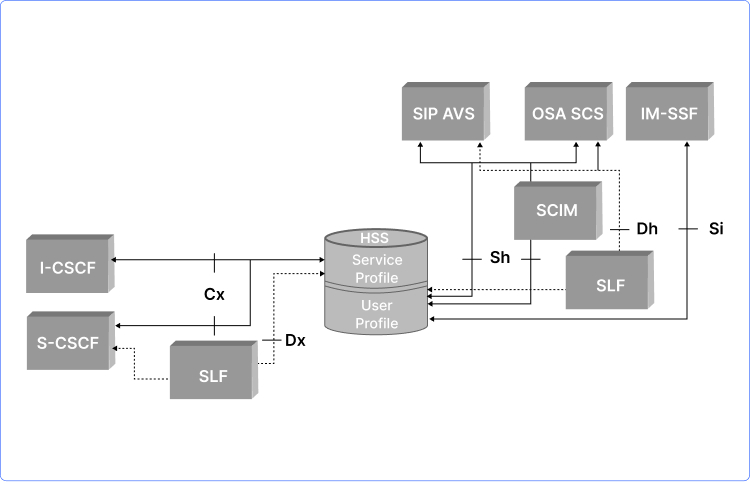
Let’s dive into some more technical details and processes on which the Diameter Protocol works—
In many IP access networks, including CDMA IP networks, a single functional element traditionally handled the Authentication, Authorization, and Accounting (AAA) function for terminal devices. This was achieved through a single AAA server utilizing the Remote Authentication Dial-in Service (RADIUS) interface.
Authentication involves proving an identity or source of information and verifying its authenticity, establishing a trust relationship with a recognized entity. Authorization establishes the privileges granted to a recognized entity, while Accounting collects information on resource consumption related to the provided service.
The IMS AAA architecture divides the AAA function between two entities. The HSS handles authorization and authentication while charging servers manage the accounting function. This setup allows for a more versatile framework supporting various accounting methods.
The Authentication and Authorization (AA) architecture relies on the service profile stored in the HSS, containing user identity and authorized multimedia services information. The authorization process accesses this service-related data, while authentication involves exchanging vectors or triplets to support the challenge handshake.
The Diameter protocol facilitates these functions for session control entities and application servers. Communication between the I-CSCF, S-CSCF, HSS (over the Cx/Dx interface), and application servers (over the Sh/Dh interface) ensures the necessary exchange of information for authentication and authorization processes.
Diameter Protocol vs RADIUS: What’s the Difference?
Now, we’re going to see this from a different aspect. Diameter protocol vs RADIUS- which one is what & what’s the difference between them, let’s figure it out right away.
In the world of networking protocols, Diameter and RADIUS play essential roles in managing Authentication, Authorization, and Accounting (AAA) functions. Diameter Protocol evolved from the older RADIUS, so, it is undoubtedly an updated version of it. However, both of them are still in use in the telecom industry and they have distinct characteristics.
What is the RADIUS Protocol?
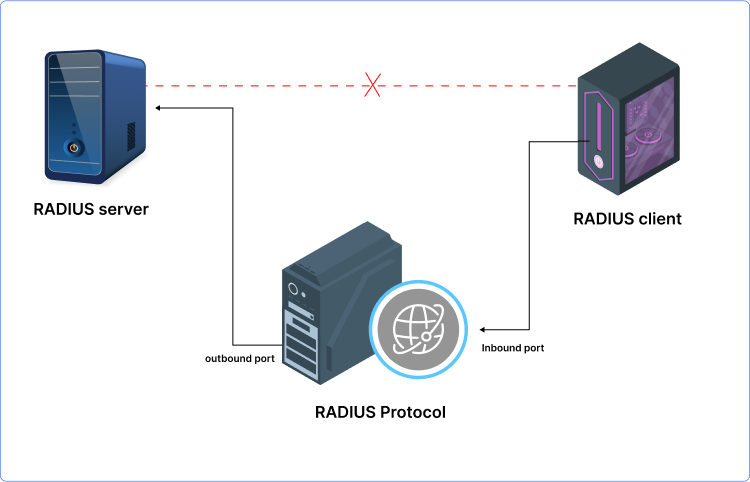
Remote Authentication Dial-In User Service or RADIUS, is a networking protocol facilitating the exchange of authentication, authorization, and accounting (AAA) data between a client and a server. Despite its widespread use, RADIUS has some drawbacks including—
- Poor scalability
- Limited extensibility, and
- A lack of certain features like support for agents, capability negotiation, and error messages.
To address these issues, experts have developed new protocols, with Diameter being one of the alternatives aimed at overcoming RADIUS’s limitations. In essence, RADIUS serves as a protocol for transmitting authentication, authorization, and configuration information between a Network Access Server seeking to authenticate its links and a shared Authentication Server.
Diameter Protocol Improvement over RADIUS
RADIUS was initially designed for basic authentication in dial-up networks. In a typical RADIUS setup, a user provides login credentials (like a user ID and password) to an access server. The access server then verifies these credentials against a centralized LDAP policy store. However, the RADIUS model faces challenges in IMS networks, especially with mobile users accessing dynamic applications and services across different service provider networks.
On the other hand, Diameter steps in to address these challenges. It supports advanced policy control, dynamic rules, quality of service, bandwidth allocation, and charging mechanisms crucial for modern communication service provider networks. Additionally, Diameter offers a more reliable, secure, and flexible framework for exchanging Authentication, Authorization, and Accounting (AAA) messages.
Differences Between Diameter Protocol and RADIUS
Clearly, RADIUS and Diameter are both AAA (Authentication, Authorization, and Accounting) protocols, but Diameter is a more advanced and feature-rich successor to RADIUS. The table below highlights the key differences between the two, showcasing how Diameter improves upon RADIUS in terms of security, reliability, and functionality. Have a look:
| RADIUS Protocol | Diameter Protocol |
| Primarily used UDP for communication | Supports both TCP and SCTP, providing more reliable and secure options |
| Simple but less extensible | Complex but more flexible |
| Supports PAP, CHAP, EAP, and other methods | Supports a wide range of authentication methods, including EAP and more secure mechanisms |
| Provides basic authorization capabilities | Offers more advanced and flexible authorization capabilities |
| RADIUS is connectionless, it does not require prior session creation | Diameter is a connection-oriented protocol |
| For authentication, it uses UDP port 1812 or 1645, and for accounting, port 1813 or 1646 | Operates on TCP and SCTP port 3868 |
| Provides Hop-by-Hop security | Provides Hop-by-Hop authentication and can also provide End-to-End security |
| RADIUS has no support for agents as it assumes a direct connection | Diameter supports agents (Relay, Proxy, Redirect, etc.) |
| Limited error code and handling capabilities | Improved error handling with a more extensive set of error codes |
| The server cannot send requests to a client | The server can deliver a request to a client |
Diameter Protocol in Telecom and Its Advantages
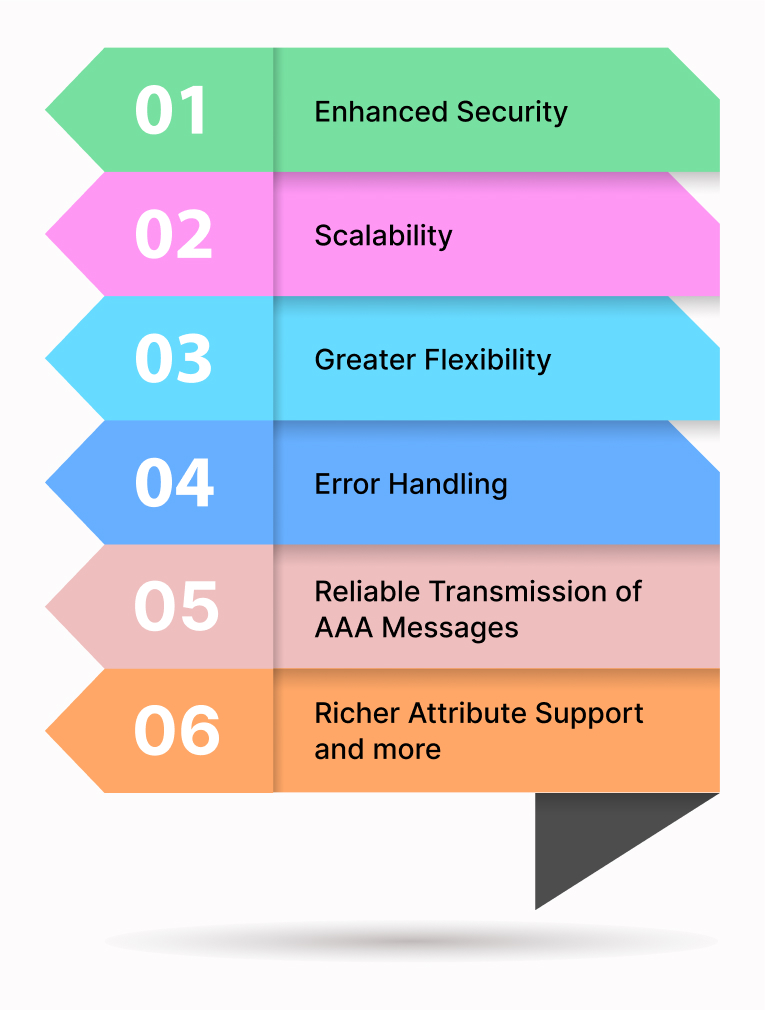
If we focus on the advantages of the Diameter Protocol, it is indeed a great technological advancement in modern telecommunications. It offers significant improvement in Authentication, Authorization, and Accounting (AAA) functions. Unlike its predecessor, RADIUS, Diameter’s Peer-To-Peer architecture allows flexible roles for hosts, acting as clients or servers based on network needs.
A standout advantage of Diameter is its seamless integration with Long Term Evolution (LTE) technology. Serving as the backbone of the Evolved Packet System (EPS) network, Diameter supports real-time transaction functionality, crucial for dynamic telecommunications environments.
Besides, it is endorsed by standardization bodies like 3GPP and ETSI NFV and ensures industry-wide compliance and interoperability. Its contribution to enhancing Domain Name System (DNS) security by monitoring network usage further solidifies its importance.
Diameter Protocol Advantages
Summing up the advantages of the Diameter Protocol in telecommunication—
- Peer-to-peer architecture for flexibility
- Reliable transmission over TCP or SCTP
- Built-in failover mechanisms
- Secure transmission with TLS or IPSec
- Enhanced security and scalability
- Error handling improvements
- Richer attribute support
Diameter Protocol Applications
Unlike your usual software applications, these Diameter-based protocols are unique protocols identified by an application identifier. Each application can introduce fresh command codes or mandatory Attribute-Value Pairs (AVPs). The interesting part is that adding a new optional AVP doesn’t mean crafting an entirely new application.
Let’s look at some real-world examples:
- Diameter Mobile IPv4 Application: Unveiling mobility solutions in the telecommunications landscape.
- Diameter Network Access Server Application: Revolutionizing how network access is handled.
- Diameter Extensible Authentication Protocol Application: Bringing flexibility and security to authentication.
- Diameter Credit-Control Application: Paving the way for credit control in communication services.
- Diameter Session Initiation Protocol Application: Streamlining session initiation for seamless communication.
- Various applications in the 3GPP IP Multimedia Subsystem: Elevating multimedia experiences in the 3GPP realm.
What’s fascinating is how these applications cater to a spectrum of needs—from mobile IP functionalities to network access management and credit control. Plus, they play a crucial role in the 3GPP IP Multimedia Subsystem, showcasing the diverse applications of the Diameter Protocol.
Conclusion
The Diameter Protocol applications in the ever-evolving landscape of telecommunications prove how crucial it is for modern communication. From secure network access to streamlining authentication and paving the way for credit control, this protocol plays a vital role in shaping our connected experiences. As we know how the diameter protocol in telecommunication works and explore the diverse functionalities, it becomes clear that Diameter has many advantages over the RADIUS protocol.
The seamless data exchange between HSS and SLF using Diameter adds an extra layer of connectivity. Moreover, the compatibility with Long Term Evolution (LTE) technology and endorsements from standardization bodies like 3GPP and ETSI NFV highlight Diameter’s relevance and industry-wide acceptance.
Frequently Asked Questions
How is the Diameter of a network calculated?
The diameter of a network is calculated by measuring the longest shortest path between any two nodes or points in the network. In simple words, diameter can be found by locating the two most distant nodes and measuring the shortest possible path or route between them.
How does a Diameter network function?
A diameter network function works on a client-server model. Here, NAS i.e. Network Access Server acts as the client and Diameter as the server. The NAS sends requests to Diameter which processes them and sends responses back.
What is the importance of Diameter Signaling in telecom networks?
Diameter signaling is a key player in telecom networks and is responsible for handling user authentication, authorization, accounting, policy enforcement, and charging in modern mobile networks such as LTE, 5G, and IMS networks.
What are some challenges or issues Diameter signaling poses in large-scale networks?
In large-scale deployments, Diameter signaling can lead to congestion and interoperability challenges. However, operators use Diameter Signaling Controllers or DSCs to address these issues and ensure efficient traffic management and load balancing.
Does the Diameter protocol support 5G networks?
Yes, Diameter supports 5G networks, however, its role is very limited compared to LTE and IMS networks. In 5G networks, diameter is used only in certain instances such as interworking between 4G and 5G to support users moving between networks, online and offline charging for 5G networks that integrate with legacy charging systems, etc.
Note – This post has been updated with the latest information on 07-03-25.




























